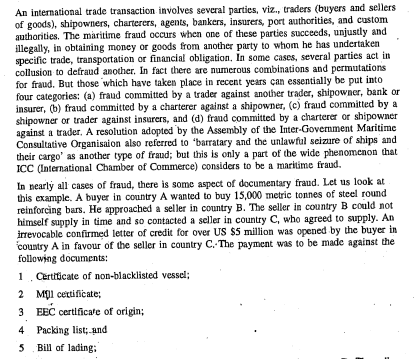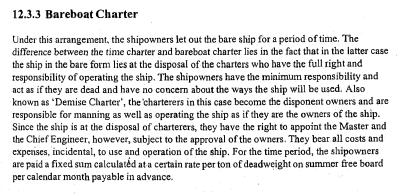Solutions to Assignments
IBO - 05 - International Marketing Logistics
Master of Commerce (M.Com) - 1st Year
Question No. 5 Write short notes on following:
a) Public Warehouse.
These warehouses are owned by government and semi government bodies and are made available to private firms to store goods on payment of rent. The public warehouses are usually set up to help small traders who are not in position to have their own warehouses due to financial constraints.
Therefore, in order to promote trade and industry, central or state governments come forward to cater such storage needs of traders/retailers. Anyone can avail these facilities to solve its short-term distribution needs. Retailers sometimes due to increased sales even find their private warehouses insufficient if their facilities have reached capacity or if they are making a special, huge purchase of products for some reasons.
For example, before festivals or before marriage seasons, retailers may order extra merchandise to avoid ‘out of stock’ situations. These warehouses are typically regulated by the government bodies. Costs incurred by the private firms for the use of public warehouses are considered as variable. These warehouses are mainly used by manufacturers/producers, exporters and importers.
b) Commercial Shipping
Depending upon how fast you want to get cargo to your customer and how much he or she is willing to spend, you might ship by ocean or air. Accordingly, there are two types of bills of lading, the ocean bill of lading and the airway bill.
An ocean bill of lading serves both as a receipt for the cargo and as a contract for transportation between you (the exporter) and the carrier. It also symbolizes ownership; accordingly, if in negotiable form, it can be bought, sold or traded while the goods are in transit.
When you use air freight, an airway bill is issued in lieu of a bill of lading. It serves as a through bill of lading which covers domestic and international flights moving cargo to a specific destination. Your air transportation carrier will advise you of the house airway bill number and the master airway bill number assigned to your shipment. You must be sure to communicate these to your customer along with other transportation details.
Airway bills serve functions similar to those of ocean bills of lading, but they are only issued in non-negotiable form. This means that you and your bank have less protection because you lose title to the goods once shipment commences. Be sure to check with your logistics expert if you are shipping hazardous goods. Special forms are required.
We will be covering ocean bills of lading in detail because ocean freight is the most economical -- and therefore the most frequently used -- method of export shipment.
You must prepare and submit a Shipper's Letter of Instructions form to your freight forwarder so that they can issue an accurate bill of lading. This form indicates if the transaction is being made against a letter of credit, whether insurance is required and where to send documents, etc. Once you've finalized terms of payment with your customer, you will be able to furnish these facts to your freight forwarder.
Most bills of lading are issued with three originals and several copies.
There are numerous different types of ocean bill of lading, but you will find that the following are the most commonly used:
A "straight" (non-negotiable) bill of lading provides for delivery to the person whose name appears on it. It must be marked "non-negotiable." Only the person named can claim the goods upon arrival. This type of bill is usually used for goods shipped on an open-account payment basis when the exporter is not concerned about the importer receiving the goods without payment.
A "shipper's order" (negotiable) bill of lading is used when you want to impose conditions on delivery of the goods, such as acceptance of a draft. This type of bill of lading works well when payment has been secured by a letter of credit because you can make sure that the terms of the L/C are met before the goods are released.
A "clean bill of lading" is issued when the shipment is received in good order. If there is any damage or a shortage of product is found, a clean bill of lading will not be issued.
An "on-board bill of lading" is issued when the cargo has been placed aboard the named vessel. It is signed and certified by the master of the vessel. For a letter of credit transaction, this bill of lading is required in order for you (the exporter) to get paid.
Of course if the goods require packing or specialist rigging Infinity can assist with this.
In the case of personnel affects the whole procedure is simpler, how much you want to spend and how much time you have.
Very often fine art is shipped in the air due to its value and small size.
c) Multi-Modal Transport Document
A document issued or signed by a carrier indicating carriage by more than one means of transportation. For example, a multimodal transport document for a door-to-port shipment with main carriage by vessel might indicate pickup at the place where the shipment originates (often the seller´s premises) with pre-carriage by truck and main carriage from the named port of loading to the named port of discharge by a named vessel. Depending on how the contact carriage was drafted, the document could be issued either on a received for shipment basis at any time after the goods entered the control of the main carrier, or on an on-board basis after the goods were loaded in the named vessel. As some ship lines accept liability only while the cargo is on their vessel, its is important to carefully read the contract of carriage.
With the advent of containers, the ocean carriers started extending their services to Inland locations, as containers, are smoothly and easily handled from one mode of transport to another. One of the most important ingredients involved in such Multimodal Transport is the existence of a legal regime to govern the terms of the contract and specify the basis of liability and responsibilities of the Multimodal Transport Operator. Previously, a documents called Combined Transport Document (CTD) was being issued. However, although the format of the document broadly conformed to a specimen prescribed by the International Chamber of Commerce (ICC), the CTD has not been adopted by all operators uniformly. Thus, there was an absence of uniformity of liability and other condition. In India the Foreign Exchange Dealers Association of India (FEDAI) has evolved its own rules laying down the responsibilities and liabilities of Combined Transport Operators from the inland container depots. However, these rules could not obtain wide acceptance mainly because the Combined Transport Document evolved by FEDAI did not confer negotiability and title to the goods and also because such documents were required to be exchanged for a regular on - board ocean bill of lading at the port unless the letter of credit specifically permitted the production of a combined transport Document in place of a regular Bill of Lading. Looking to the urgent need of Industry and keeping in view the provisions of the Multimodal Transportation of Goods Act 1993 which is substantially based on the rules framed by the ICC and also taking into account the provisions of the UN Convention of 1980 on Multimodal Transportation of Goods, the Director General of Shipping, with the approval of the Govt., has issued an Order on 17th March, 1994 prescribing a model for the Multimodal Transport Document (MTD). The document has been prepared for carrying out the provisions of the Act keeping in view the primary objective of the legislation that the carriers are thereto serve trade and not the other way around. The Multimodal Transport Document issued under the present law would be:i) a contract for the Transportation of Goods by Multimodal Transport.ii) a negotiable document unless it is marked non negotiable at the option of the consignor.iii) a document of title on the basis of which its holder can take delivery of the goods covered by it.The concerned parties who would have commercial interest who would be governed by the document once it is executed would be:i) The MTO who is the person responsible for the execution of the Multimodal Transport Contract.ii) The consignor who places the goods in question with the MTD for transporting the same and the consignee who is to take delivery at the destination.iii) The bankers who would provide the mechanism for documentary credit.iv) The insurers who insure the goods against loss or damage and the liability insurers who would cover the MTO's liability under contract.
MTD AS AN INSTRUMENT TO ENFORCE THE PROVISIONS OF THE ACT.
Once the Multimodal Transport Operator executes the Multimodal Transport Document, he immediately assumes the role of the owner of the goods, the Principal thereby authorizing the MTO to exercise the rights as that of the owner for claiming damages etc. and for other purposes, wherever necessary. The provisions of the Act shall have overriding effect over all other laws and any contract for MULTIMODAL Transport made in contravention of the provisions of the Multimodal Transport Act would be null and void.The issuance of the Multimodal Transport Document confers and imposes on all interested parties the rights, obligations and defences set out in the act. In issuing the MTD, the MULTIMODAL transport operator assumes responsibility for the execution of the contract as well as would be liable for the loss or damage to goods or delay in delivery as contained in the Multimodal Transportation of Goods Act 1993.
d) Privatisation of Ports
In recent years a significant number of countries have implemented policies aimed at reforming their port industry. In the belief that it will improve efficiency and reduce the heavy financial burden placed upon governments that attempt to support such a capital-intensive industry, privatization has often formed an important strand of such policies. A key claim in favour of privatization is that the transfer of ownership from public to private hands will ultimately lead to an improvement in economic efficiency and, hence, financial and operational performance. This paper investigates the theoretical underpinnings and practical validity of this claim and concludes that privatization is only a partial cure for what ails the world's ports and that, if implemented in isolation, it simply cannot deliver the much-needed panacea for the industry's woes.
The Major Ports Authority Bill, 2020 was passed through ballot votes in the Rajya Sabha on Wednesday with 84 votes in its favour and 44 against it. The Lok Sabha had passed the bill on September 23 last year.
Taking a strong objection to some members' remarks that it is intended to benefit big corporate houses and would result in the ruining of the ports and their plunder, Mandaviya, in his reply to the debate on the bill, said rather, it would turn these ports into world-class ports and enable their boards to take decisions on their own.
Various opposition parties, including the Congress, TMC, SP, RJD, DMK, AAP, CPI(M) and CPI raised objections on the bill in the Upper House of Parliament and alleged that it is aimed at privatising the ports and diluting the powers of the states on land use. However, the BJD, JD(U), YSRCP supported it, saying it is a welcome move to expand the port development infrastructure.












